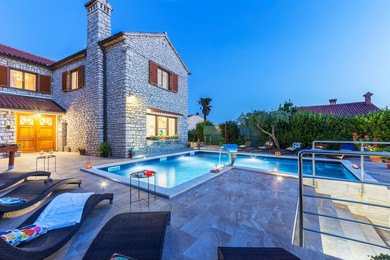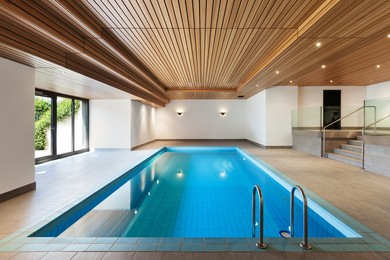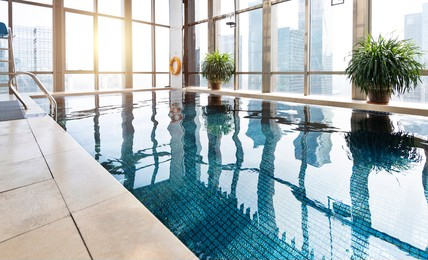Luxury, relaxation, and recreation have always been associated with swimming pools. It’s hard to deny the appeal of having a swimming pool in one’s backyard-from the sparkling waters to a refreshing dip on a hot summer’s day. Many homeowners are thinking about building a pool to create a personal oasis where they can relax, work out, and have fun.
But before you get started, make sure you understand how much space you’ll need. You could make costly mistakes, limit functionality, or get in legal trouble if you don’t consider the available space.
I’m going to discuss the intricacies of determining how much space a swimming pool needs.
Swimming Pool Sizes
Here are some common ranges for residential swimming pools:
Outdoor Pools

Small Pools:
Small pools are typically designed for relaxation, exercise, or cooling off. They can range in size from 10 feet by 20 feet (3 meters by 6 meters) to 15 feet by 30 feet (4.5 meters by 9 meters). These pools are suitable for smaller yards or limited space.
Medium Pools:
Medium-sized pools are more versatile and can accommodate both recreation and swimming laps. They generally range from 15 feet by 30 feet (4.5 meters by 9 meters) to 20 feet by 40 feet (6 meters by 12 meters). These pools offer a good balance between space and functionality.
Large Pools:
Large pools are ideal for families or those who entertain frequently. They can be larger than 20 feet by 40 feet (6 meters by 12 meters) and may have additional features like diving boards, slides, or shallow lounging areas.
Olympic-sized Pools:
Olympic-sized pools are used for professional swimming competitions and training. These pools are much larger, typically measuring 50 meters by 25 meters (164 feet by 82 feet), with a depth of about 2 meters (6.5 feet). They require a significant amount of space and are not common for residential use.
Indoor Pool Sizes

Lap Pools: Typically, a lap pool ranges in length from 25 to 50 feet and in width from 8 to 10 feet, depending on your primary use of the pool.
Recreational Pools: According to the available space, a pool similar to the medium-sized outdoor pools mentioned above can be appropriate for family enjoyment and recreational activities.
How Much Space Do I Need for A Swimming Pool?
The amount of space required for a swimming pool depends on various factors, including the size and shape of the pool, local regulations, and personal preferences. Here are some general considerations:
Pool Size
The dimensions of the pool will determine the space needed. Common pool sizes range from small backyard pools of about 10 feet by 20 feet (3 meters by 6 meters) to larger ones that can be 20 feet by 40 feet (6 meters by 12 meters) or even larger.
Pool Shape
The shape of the pool can impact the space required. Rectangular pools tend to require less space compared to irregular or custom-shaped pools.
Decking and Surroundings
It’s important to consider the space needed for a pool deck or patio area surrounding the pool. This space is often used for seating, lounging, and other recreational activities.
Safety Requirements
Local building codes and safety regulations may dictate the minimum distance required between the pool and surrounding structures, such as fences, buildings, or trees. These requirements can vary, so it’s essential to consult with local authorities.
Access and Equipment
Adequate space should be allocated for pool equipment, such as filters, pumps, and heaters. Additionally, access pathways for maintenance and potential repairs should be considered.
Landscaping and Amenities
If you plan to incorporate landscaping features, water features, or additional amenities like a pool house or a spa, you’ll need to allocate space accordingly.
Position and Location for the Swimming Pool Space

Here are some key considerations:
- Sun Exposure: Ideally, the pool should be located in an area that receives ample sunlight throughout the day. This helps to maintain the water temperature and provides a pleasant swimming experience. Avoid placing the pool in the shadow of tall buildings, trees, or other structures that can block sunlight.
- Privacy: Consider the level of privacy you desire for your pool area. Position the pool away from neighboring properties or use landscaping elements like fences, hedges, or trees to create a private and secluded space.
- Accessibility: The pool should be easily accessible from your home and other outdoor areas. Consider factors like the proximity to the main entrance, changing rooms, and outdoor entertaining spaces. It’s also essential to ensure that there is a clear and safe pathway to the pool area.
- Views and Landscaping: Take advantage of any scenic views or natural surroundings when determining the pool’s position. Consider the visual aesthetics and integrate the pool design with the existing landscape. You may want to position the pool to maximize the views or create a focal point in the outdoor space.
- Safety and Regulations: Be aware of local regulations and safety requirements when selecting the location. There may be specific setback requirements from property lines, structures, or septic systems. Consult with local authorities or pool professionals to ensure compliance with safety codes and regulations.
Related: What Is The Average Time To Swim 1 Kilometer?
FAQs
What is the minimum space needed for a swimming pool?
The minimum space needed for a swimming pool depends on various factors, including the type of pool, local building codes, and safety regulations. Generally, for an average-sized pool, you would need a space of at least 25 feet by 40 feet (7.6 meters by 12.2 meters) or larger. However, it’s important to check with local authorities and consult with a pool professional or contractor to determine the specific requirements in your area.
What is the size of a normal swimming pool?
The size of a normal swimming pool can vary widely. In residential settings, a typical pool size ranges from about 10 feet by 20 feet (3 meters by 6 meters) to 20 feet by 40 feet (6 meters by 12 meters) or even larger. Commercial or public pools can be much larger and may follow standard sizes, such as Olympic-sized pools, which are 50 meters long and 25 meters wide.
Can you put a pool in a small space?
Yes, it is possible to put a pool in a small space, but it would require careful planning and consideration of the available area. Compact pools, such as plunge pools or small lap pools, can be designed to fit into smaller spaces. However, it’s important to ensure that the space meets local building codes, and safety regulations and provides enough room for circulation around the pool.
How much space do you need for a 12×24 pool?
For a 12×24 pool (12 feet wide by 24 feet long), you would ideally need a space that is slightly larger than the pool dimensions to allow for decking, equipment, and circulation space. A recommended minimum space for a 12×24 pool would be around 14 feet wide by 26 feet long (4.3 meters by 7.9 meters).
How close to my house can I put a pool?
The proximity of a pool to your house is typically regulated by local building codes and safety regulations. It is generally required to maintain a certain distance between the pool and the house for safety reasons. The specific requirements can vary depending on your location, so it’s important to consult with local authorities or a pool professional to determine the minimum distance required in your area.